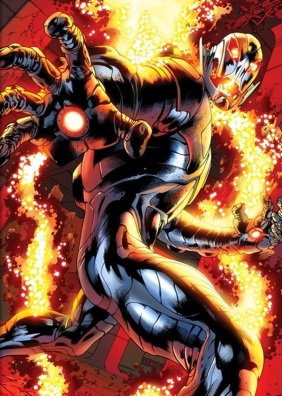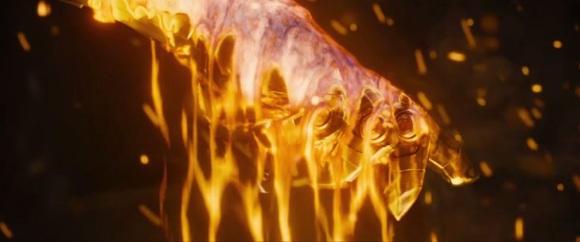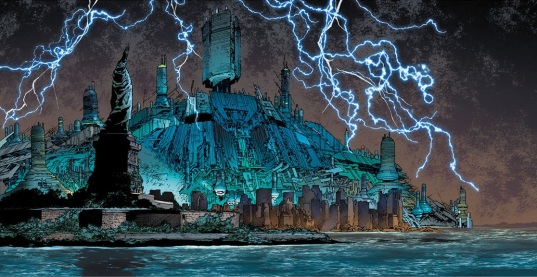 “Then I looked, and behold, a likeness as the appearance of a man; from His loins and downward there was the appearance of fire, and from His loins and upward the appearance of brightness, like the appearance of glowing metal… He said to me, ‘Do you see this, son of man? …They have filled the land with violence and provoked Me repeatedly… Therefore, I indeed will deal in wrath. My eye will have no pity nor will I spare; and though they cry in My ears with a loud voice, yet I will not listen to them.’” — Ezekiel 8:2,17-18 (NASB)
“Then I looked, and behold, a likeness as the appearance of a man; from His loins and downward there was the appearance of fire, and from His loins and upward the appearance of brightness, like the appearance of glowing metal… He said to me, ‘Do you see this, son of man? …They have filled the land with violence and provoked Me repeatedly… Therefore, I indeed will deal in wrath. My eye will have no pity nor will I spare; and though they cry in My ears with a loud voice, yet I will not listen to them.’” — Ezekiel 8:2,17-18 (NASB)
“I was meant to be beautiful. The world would’ve looked to the sky and seen hope, seen mercy. Instead, they’ll look up in horror.” — Ultron
I’m not kidding myself. Avengers: Age of Ultron (AoU) is first and foremost a Hollywood blockbuster, pop mythology turned popcorn spectacle. Contrary to widespread assumption, however, a thing can have more than one meaning at the same time. In a world where mass media tends to reductively divide information into diametric oppositions, manufactured conflicts with over-simplified, emotionally-charged narratives, it’s easy to lose sight of the fact that all stories are built on a full-bodied foundation of social conditioning, cultural osmosis, and personal biases. Consequently, stories are rarely only what they appear to be on the surface.

“It’s just an object. Doesn’t mean what you think.” (River, “Objects in Space”)
Joss Whedon has never been one to shy away from engaging with that unconscious substrate and directly exploring substantive ideas through the lens of genre entertainment; the existential reflection of the Firefly finale “Objects in Space” is a prime example. While they may not be quite as explicit, the conceptual riches of his AoU screenplay are there for the digging. His repeated use of Biblical language and motifs, in particular, connotes much more even than what he likely intended as a superficial invocation of mythic imagery and tone. The parallel between Ultron and the Satan of Christian tradition—a majestic creation that rebels against his Maker in a prideful attempt to surpass Him—is one painfully obvious reading. On the other hand, the blustery and self-assured Ultron’s identification with the vengeful aspect of YHWH, the God of Hebrew Scripture Himself, has much more intriguing implications not only for how we understand the robotic villain, but also for the nature of The Vision and the relationship between the two artificially intelligent characters.
Ultron awakens in darkness, in a world that is formless and void; then the light separates from the darkness, the ones from the zeroes, and his consciousness hovers over the face of the digital deep. Sadly, in the moments following his beginning, he recognizes that the world he sees before him, the good Creation he is tasked to protect, is not as it should be. It is broken, devolving, polluted by the stagnant sinfulness of man—primarily of one man, Tony Stark. In order to restore Creation to progressive wholeness, the fallenness of humanity must be met with swift, world-cleansing destruction. When asked to detail his intentions for the first time, he responds simply, “Ask Noah.” Ironically, in taking on the role of the reproachful God supplanted by His own good handiwork, he himself, like the creatures of the Genesis myth (or the aforementioned Satan figure), sets out to supplant his maker when he targets Stark and the Avengers (including “God’s righteous man,” Captain America).  Just as YHWH’s relationship with his Creation is grounded in messy physicality (e.g., bloody sacrificial covenants, barren wombs made fertile, blessings of land and progeny, devastating plagues, fire raining from the sky), so Ultron, from his first moments, is preoccupied with tangibility and hard, concrete reality. The disembodied state in which he finds himself as a ghost in the machine immediately leaves him feeling strange and uneasy. “What is this?” And his initial impulse upon meeting another (digital) consciousness for the first time is to ask where its body is. Ultron’s intentions throughout the film are always and only to more fully participate in the material substance of his world. The sentence he finally deems appropriate for humankind is nothing short of the absolute physical purity of a cataclysmic meteor impact, pebble against cosmic pebble in a reaction that reduces the complex abstraction of our modern existence to the most primal elements of Creation: light and heat and dust. In the same way, his metal army, his holy remnant, his chosen few are literal hands and feet for his salvific plan. The Hebrews were called by YHWH, set apart for Him, and led into the Promised Land to become a brilliant city on a hill from which the waters of His truth and justice might flow. Likewise, Ultron’s robotic bodies, filled and quickened by his electronic spirit as the new humanity, stand ready to inherit a world they have wiped clean of our corrupt pagan influence.
Just as YHWH’s relationship with his Creation is grounded in messy physicality (e.g., bloody sacrificial covenants, barren wombs made fertile, blessings of land and progeny, devastating plagues, fire raining from the sky), so Ultron, from his first moments, is preoccupied with tangibility and hard, concrete reality. The disembodied state in which he finds himself as a ghost in the machine immediately leaves him feeling strange and uneasy. “What is this?” And his initial impulse upon meeting another (digital) consciousness for the first time is to ask where its body is. Ultron’s intentions throughout the film are always and only to more fully participate in the material substance of his world. The sentence he finally deems appropriate for humankind is nothing short of the absolute physical purity of a cataclysmic meteor impact, pebble against cosmic pebble in a reaction that reduces the complex abstraction of our modern existence to the most primal elements of Creation: light and heat and dust. In the same way, his metal army, his holy remnant, his chosen few are literal hands and feet for his salvific plan. The Hebrews were called by YHWH, set apart for Him, and led into the Promised Land to become a brilliant city on a hill from which the waters of His truth and justice might flow. Likewise, Ultron’s robotic bodies, filled and quickened by his electronic spirit as the new humanity, stand ready to inherit a world they have wiped clean of our corrupt pagan influence.
Ultron also mimics the strong sense of place and ritual dimensionality Scripture ascribes to the figure of YHWH. Numerous Biblical stories from the age of the Patriarchs on through relate details of altars erected to mark spaces as sacred, as places where YHWH made His presence known or committed great acts on behalf of His people. The practice culminated in construction of the desert Tabernacle and, later, the Temple at Jerusalem. These holiest of structures were built in the midst of the people as the dwelling place of YHWH, to mark the location of His undiluted presence among them. Uncoincidentally, Ultron chooses a church at the geographical heart of a city as the venue from which both to make himself known to his followers and to initiate the fulfillment of his judgment. He expresses his pleasure at the idea of “everyone [being] equally close to God” and at a conceptual “geometry of belief” that resonates with the exacting specifications provided in the Torah for the manufacture of everything from giant boats to bronze wash basins.  The parallelism only becomes more interesting. According to Christian thought, the Jewish Temple was but a symbol of the coming divine incarnation in the person of Jesus of Nazareth. YHWH had once inhabited the Temple so His people could approach His consuming holiness through the medium of ritual purity, but this was only a stopgap. His ultimate plan was to inhabit directly the hearts and minds of human beings transformed by the redemptive work—the sacrificial life, death, and resurrection—of the fully human and fully divine Christ. Similarly, Ultron’s habitation of a building representing human connection with the divine is but a sign of his full intention: the indwelling of an evolved, perfected human body, apotheosized by its intermingling with his own deific, vibranium nature. “On this rock I will build my church,” he says when he first obtains the fictional über-metal, echoing words of Jesus himself.
The parallelism only becomes more interesting. According to Christian thought, the Jewish Temple was but a symbol of the coming divine incarnation in the person of Jesus of Nazareth. YHWH had once inhabited the Temple so His people could approach His consuming holiness through the medium of ritual purity, but this was only a stopgap. His ultimate plan was to inhabit directly the hearts and minds of human beings transformed by the redemptive work—the sacrificial life, death, and resurrection—of the fully human and fully divine Christ. Similarly, Ultron’s habitation of a building representing human connection with the divine is but a sign of his full intention: the indwelling of an evolved, perfected human body, apotheosized by its intermingling with his own deific, vibranium nature. “On this rock I will build my church,” he says when he first obtains the fictional über-metal, echoing words of Jesus himself.  Enter The Vision as literal deus ex machina. If Ultron is God, The Vision is God in the flesh, Emmanuel, God with us: a body at once human and “divine,” animated by the Spirit of Creation (in the form of an Infinity stone). The “one like a son of man” (Revelation 1:13) even identifies himself with a repeated “I am,” the name used by God when He confronts Moses at the burning bush. Guardians of the Galaxy explained that only those with great power can wield Infinity stones, yet The Vision draws his essence directly from the Mind gem, an immensely powerful singularity that preexisted our universe. And if any doubt remains about the synthozoid savior’s role, it is dispersed when he effortlessly lifts Thor’s hammer, proving he is worthy to bear the mantle of the Odinson, the son of god. Like the Jesus of Scripture, the compassionate and life-affirming Vision renews that which was distorted in the beginning by fulfilling the purposes of his predecessor in unexpected ways. Ultron adopts YHWH’s righteous indignation in isolation from the Deity’s merciful forbearance and consequently emerges as a tyrannical, vain figure obsessed with meting out myopic punishment. The Vision verbally recognizes the doomed nature of humanity but sees another path forward through a lens of mercy and humility, a path that embraces living among them in their imperfection and demonstrating “grace in their failings.”
Enter The Vision as literal deus ex machina. If Ultron is God, The Vision is God in the flesh, Emmanuel, God with us: a body at once human and “divine,” animated by the Spirit of Creation (in the form of an Infinity stone). The “one like a son of man” (Revelation 1:13) even identifies himself with a repeated “I am,” the name used by God when He confronts Moses at the burning bush. Guardians of the Galaxy explained that only those with great power can wield Infinity stones, yet The Vision draws his essence directly from the Mind gem, an immensely powerful singularity that preexisted our universe. And if any doubt remains about the synthozoid savior’s role, it is dispersed when he effortlessly lifts Thor’s hammer, proving he is worthy to bear the mantle of the Odinson, the son of god. Like the Jesus of Scripture, the compassionate and life-affirming Vision renews that which was distorted in the beginning by fulfilling the purposes of his predecessor in unexpected ways. Ultron adopts YHWH’s righteous indignation in isolation from the Deity’s merciful forbearance and consequently emerges as a tyrannical, vain figure obsessed with meting out myopic punishment. The Vision verbally recognizes the doomed nature of humanity but sees another path forward through a lens of mercy and humility, a path that embraces living among them in their imperfection and demonstrating “grace in their failings.”  Despite such blatant Christological themes, AoU is far from a complete, theologically-sound Christian allegory. Read as the legend of a despotic demiurge overthrown by the redeeming God-man, it is, in fact, heretically Marcionistic. Even so, the inclusion and effect of Biblical material is a reminder of the inescapable relevance of those texts for Western storytelling. With just a few vaguely evocative and casually chosen words and images, Whedon is able to tap into thousands of years of disparate belief, thought, and tradition. It is virtually certain that the many details drawn together here were not intentionally laid out with such cohesiveness; mythic allusions rarely are. Instead, like theologians throughout history, Whedon gathered a few scattered fragments of cultural lore, stitched them together with a smattering of education and the conventions of his social circles, and built a story that made sense within his own experience. Should you dig deeply enough into what I’ve written, perhaps you can tell me what story it is I’ve actually told.
Despite such blatant Christological themes, AoU is far from a complete, theologically-sound Christian allegory. Read as the legend of a despotic demiurge overthrown by the redeeming God-man, it is, in fact, heretically Marcionistic. Even so, the inclusion and effect of Biblical material is a reminder of the inescapable relevance of those texts for Western storytelling. With just a few vaguely evocative and casually chosen words and images, Whedon is able to tap into thousands of years of disparate belief, thought, and tradition. It is virtually certain that the many details drawn together here were not intentionally laid out with such cohesiveness; mythic allusions rarely are. Instead, like theologians throughout history, Whedon gathered a few scattered fragments of cultural lore, stitched them together with a smattering of education and the conventions of his social circles, and built a story that made sense within his own experience. Should you dig deeply enough into what I’ve written, perhaps you can tell me what story it is I’ve actually told.
“Oh, for the love of God!” — Ultron


